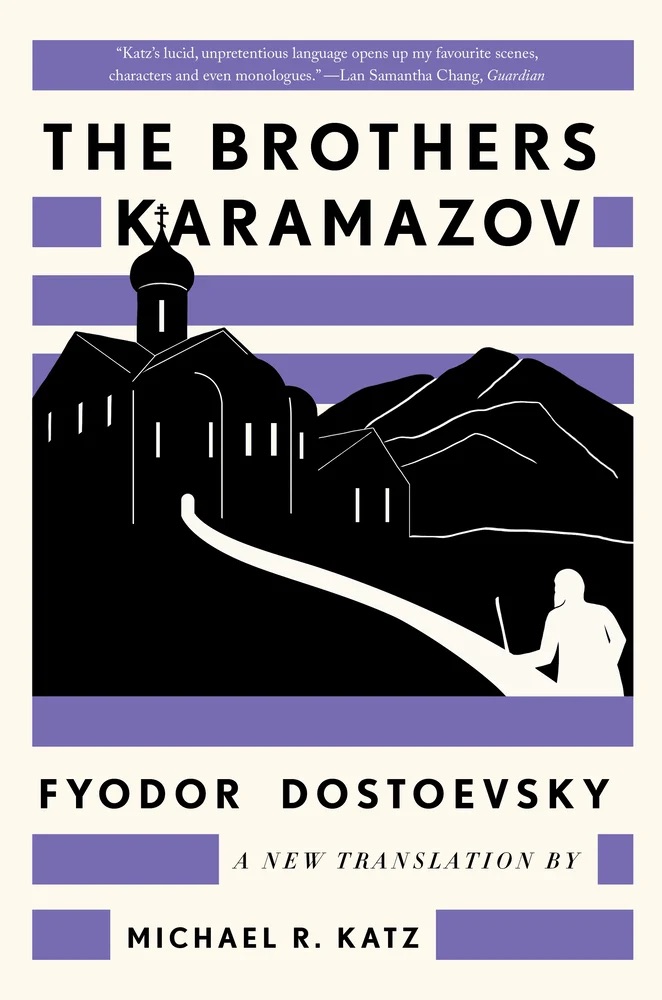Reading translated literature originating from the pens of a variety of translators could mean reading radically different versions that might scarcely correspond to one another. For me, this has held especially true with Russian literature. Brat’ya Karamazovy by Fyodor Dostoyevsky, known to English-language readers as The Brothers Karamazov, offered me a prime example.
David Magarshack in 1958 translated the book’s famous phrase трагИЧecкoй И тёмной as “tragic and mysterious,” as did Andrew MacAndrew in 1970.
David McDuff, in 1993, rendered it as “tragic and fishy,” while Ignat Avsey, in 1994, used “violent and mysterious” (the least literal translation). A French translation used the perfect phrase “tragique et noir.”
Michael Katz in 2024 chose “dark and tragic,” which came close to the French version. It fit the novel, for it referred to the violent demise of Fyodor Pavlovich Karamazov, the family’s patriarch, an event certainly tragic, but also dark in a sense of not quite above-board, certainly suspicious, an appropriate device in a novel resembling primarily a whodunit mystery.
Besides a mystery, Dostoyevsky also wrote it as a family saga, as a romance, as a religioushistorical story, and as a courtroom drama. Such a confluence of genres comprised in a work of high-culture philosophical latitude would offer something for everyone.
The three title characters (in birth order) Dmitry, Ivan, and Alyosha have little in common. The eldest led a dissolute, drunken life, the middle brother exuded reason and understanding, and the youngest dwelt in piety and self-sacrifice, a substantial triple-combo for tension. The novel showed plenty of conflict.
Who killed the elder Karamazov? Dostoyevsky used that critical question as an excuse to venture into themes of philosophy, theology, free will, and entirely new ideas at the time, such as atheism, nihilism, and socialism, putting 19th century Russia at the world’s center of philosophical fiction. Something for everyone.
Originally serialized in the Russian Messenger between 1879 and 1880, the novel repackaged the serial publications as chapters. Readers should pay close attention to the chapter “The Grand Inquisitor,” a tale told by Ivan to Alyosha, which made it a story within a story and a story with a rather unforgettable ending.
Ivan’s story discussed the Spanish Inquisition, in which Christ returned to earth, and crowds followed him until the Grand Inquisitor confronted him. At that point, Ivan’s story turned political, substituting the freedom to choose heaven versus earth with the rock-or-ahard-place options of Czarist serfdom-capitalism versus the not-yet-arrived communism.
The novel provided excellent insights into the peasantry as the Czar’s state ailed in slowmotion decline (it failed disastrously only one generation later). Dostoyevsky presented the concept of Christ as standing for capitalism, in which peasants needed to work to eat, for no
failsafe would feed them.
Few books could make readers comprehend the arrival of Communism as well as this one. Had Lenin read the novel? He must have.
Readers ought to remember that nonfiction changed minds while fiction changed hearts.
The chapter about the Grand Inquisitor sparked many secondary publications, even a play. Most of them focused on its surprise ending, whose revelation would spoil reading enjoyment.
The work influenced Virginia Woolf, Cormac McCarthy, Haruki Murakami, Franz Kafka, and my favorite, James Joyce. William Faulkner compared it to Shakespeare and the Bible. Readers interested in the novel’s influence on Wittgenstein, Heidegger, and Nietzsche should search Mount Tamalpais College’s EBSCO for “Existential struggles in Dostoyevsky’s the Brothers Karamazov” by Dennis Vanden Auweele.
The novel has had huge influence on my writing, largely because of its peculiar narrator. “Unreliable” would not even begin to describe him, “fickle” or “capricious” would have greater accuracy. He seemed a gossipmonger who talked just because he liked to talk and would gladly do so with anyone who would listen. His facts… well, they sometimes varied, depending on the listener.
It greatly inspired me with the scarcity of the narrator’s self-referential use of the ninth letter of the alphabet, making me wonder about agency. Did the narrator have agency — did he pursue reporting of the story? — or did he stumble upon it at random?
The book at times casually mislaid its pointof-view and proceeded without one, which made it even more of a curiosity. The narrator could not possibly have overheard all the dialogue that drove the story, whose scenes played either in hushed, secret whispers or in loud, secret shouts, mostly between the brothers.
How would the narrator have received such information? Though omniscient, he looked like an ignoramus; a simpleton who constantly made errors in speech and manner that came across as comic relief, but really made him look a wretchedly uneducated rural fool, quite unlike the highly educated, urbane St. Petersburg writer who created him.
In my undergraduate comparative literature class, students read the book simultaneously with David Copperfield by Charles Dickens. The fourth (though illegitimate) brother Smerdyakov reminded me of Dickens’s unforgettable character Uriah Heep, and the parallels of Dostoyevsky’s women and Dickens’s women seemed uncanny. Did one novelist influence the other?
The Katz translation marked my fifth reading of Dostoyevsky’s masterpiece, each by a different translator. Readers who might not like one translation should simply try a different one. The translation by Richard Pevear and Larissa Volokhonsky (1990) earned the highest critical acclaim; anyone seeking to channel Victorian propriety should try the Constance Garnett rendition. Eventually, a suitable version of this must-read novel would come along.
